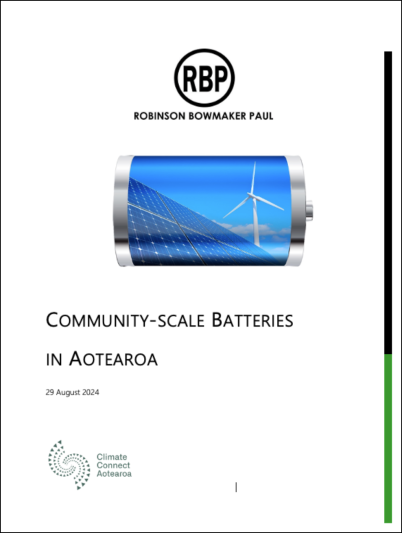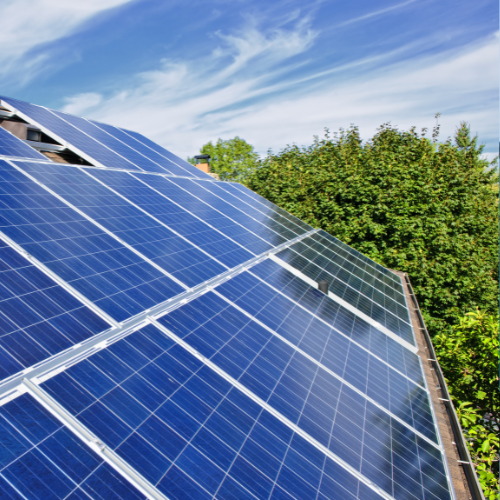Aotearoa New Zealand faces a critical energy transition, balancing carbon reduction, affordability and resilience. This Climate Connect Aotearoa commissioned report explores the promising potential of community energy storage as a solution.

Aotearoa New Zealand, like many nations around the world, is navigating an urgent energy transition to meet carbon reduction targets and address the rising cost of energy. Meeting these challenges requires transitioning to an energy system that is more flexible, equitable, affordable and sustainable. Another driver for change is the need to build more resilience into the system in the face of the growing impact of climate change.
Energy sharing – for example, storing excess solar energy produced by households and businesses in batteries and sharing it across their local communities – is one potential response to these challenges. However, this will require addressing factors such as the low uptake of household solar panels, regulatory and commercial barriers, and technical and infrastructure challenges.
As part of our role in supporting climate innovation, Climate Connect Aotearoa commissioned this report, building on insights from Ara Ake to examine the potential for neighbourhood-scale energy storage, or community batteries, in New Zealand's energy transition and how the challenges might be addressed.
What are community batteries?
A community battery is a large energy storage system located within a community or neighbourhood. Put simply, they work in a similar way to household batteries that store surplus energy from solar panels on the roof of your home. But they’re much larger (typically 100kWh to 1MWh), and they store surplus energy from multiple homes or businesses. That energy can then be supplied back to the community when needed through a combination of smart energy management systems and bidirectional energy flows.
Why are they important?
Interest in community batteries is being driven by the rise in rooftop solar energy systems globally. Currently, surplus energy from these systems can be fed back into the electricity grid. But experience in Australia, for example, shows if there’s too much solar energy going back into the grid it can cause problems. It may ‘overload’ the transmission network, create operational issues and drive price volatility.
Community batteries help get around those problems by storing that excess energy in the local community, where it can be used later, for example, at times of peak demand or when there's not enough solar energy.
Community batteries have been trialled in Australia, where the uptake of rooftop solar systems is much higher than in New Zealand. In 2023, around one-third of all Australian homes had rooftop solar panels compared with around 2.6 per cent in New Zealand[1] (although the number of installations is growing quickly). However, only 1.5 per cent of Australian homes with rooftop solar systems had battery storage.
High uptake of rooftop solar without storage can destabilise the network and force network operators to curtail the export of electricity from rooftop solar systems back into the grid. In response, Australian federal and state governments have committed $300 million to support community battery initiatives. This report looks at some of the key outcomes from those trials.
Benefits of community batteries
Community batteries offer a range of potential benefits to stakeholders across the energy ecosystem.
Technical / network benefits
Community batteries can help improve the overall performance of the electricity network and the transition to a more decentralised grid. Technical benefits include:
- Improved local network stability – as the demand on local networks grows, we can expect an increase in grid fluctuations. The flexibility of local battery storage means network operators can respond quickly to these fluctuations and keep power flowing
- Reduced network losses, by keeping energy ‘local’ rather than exporting it back into the grid
- Better network efficiency in high-demand periods through a greater ability to manage power flows in and out of local networks
- More effective use of the solar energy produced by households and businesses, for example:
- ensuring more solar energy is stored and used as and where it’s generated
- reducing network congestion from excess solar energy flowing back into the network.
Economic benefits
The technical benefits described above typically create economic benefits as well, for example:
- A reduced need for investment in transmission networks and fewer outages (avoiding the high cost of ‘lost load’)
- Economies of scale – a single large battery costs less for each unit of storage than multiple distributed retail batteries owned privately by homeowners
- The ability for households to ‘energy shift’ (store excess energy when it’s cheap and use it during more expensive peak times) can also help lower consumers’ energy bills.
Social benefits
As the name suggests, community batteries offer many benefits to local communities and neighbourhoods – especially given the increased focus on and importance of energy in our lives and the communities we live in. For example:
- Improved community resilience – the impact of grid outages and disruptions, often linked with climate change and adverse weather effects, is well documented. Community batteries are a local energy source that can keep the lights on for weather-impacted consumers exposed to more frequent outages.
- Greater trust and engagement with the energy sector – especially if local users are actively involved with the design and operation of the initiative.
- Increased knowledge amongst consumers of energy systems and how they work. This helps create both more trust in the energy sector and greater support for new technology, which can deliver better outcomes for consumers.
- Building connections and social cohesion – community batteries can serve as a tangible symbol of a collective local commitment to energy sharing, efficiency, climate action and decarbonisation.
- Addressing inequality – community batteries can help those households who cannot afford to install solar rooftop systems to still access some of the benefits of solar energy.
The investment case for community batteries
While community batteries have the potential to deliver a range of significant benefits, many (such as greater community resilience and cohesion) are difficult to quantify, assess and monetise. This poses a barrier to their uptake, given that investment cases typically focus on financial returns and commercial viability. Experience from Australian community battery trials shows that given existing tariff structures and current high capital costs of batteries (which should decline over time), trials are unlikely to deliver positive net benefits without subsidies and/or specialised tariff structures that recognise community batteries' contribution to the network. In the short term, a wider assessment, which considers financial and non-financial benefits, is likely to be key to the uptake of community battery initiatives in New Zealand.
Lessons from community battery trials in Australia
The report reviewed six community battery trials in various locations across Western Australia, Victoria and New South Wales. A key finding was that community-scale batteries can be installed and used in Australia without major regulation changes.
Financial outcomes:
The main measure of success for the trials was a reduction in the electricity bills of participants. While this objective was achieved, it is important to note that modelling shows community battery trials were only financially feasible if network tariffs were discounted. Under existing tariffs, batteries incur charging and discharging costs, essentially double-charging. This can be addressed by introducing Local Use of System (LUoS) charges, which recognise the contribution of the battery to the local network. The high cost of community batteries also meant subsidies were also key to the financial viability of trials.
Other benefits:
Other benefits reported included reduced network demand in peak periods, stabilisation of the grid, time-shifting of excess local solar energy from daytime to evening peaks, and increased community-wide access to locally produced renewable energy.
Business models
The trials were developed with a range of different business models. Battery owners have included distributors, retailers, not-for-profit community groups and a property developer (in partnership with a retailer). Operators have included distributors, retailers and community groups.
While the ability to ‘value-stack’ (access multiple revenue streams) has a significant impact on the commercial attractiveness and viability of projects, the business model chosen can affect the viability of this.
Retail ownership
Retail owners could use community batteries to:
- arbitrage and manage their exposure to wholesale spot prices
- offer network flexibility services, such as peak reduction, to distributors
- offer balancing and ancillary services to local power system operators.
The New Zealand regulatory framework largely enables retailers to provide such services if network businesses are prepared to purchase them. (However, there are currently no developed markets for network flexibility services in New Zealand, meaning services would need to be defined and developed.)
Retailer ownership offers the smoothest connection with consumers. However, depending on their objectives for a community battery (e.g., to optimise their own exposure), this could reduce benefits for local communities unless appropriate contractual provisions were in place to ensure savings and benefits are passed onto the community.
Distributor ownership
Distributors know the local network, understand where community batteries should be best located from a network perspective, and can adjust network tariffs to reflect the benefits. However, New Zealand regulations impose restrictions on distributors, which prevent them from participating in the wholesale energy and ancillary services market.
Third-party ownership
Ownership by third parties such as community trusts, local government or private companies is also possible and is a feature of some Australian trials. They have the same ability to ‘value-stack’ as retailers, however, they may need more technical knowledge or the required relationships for these projects. Community organisations may also have financial constraints that make it challenging to fund the significant initial capital expenditure required.
Building a resilient energy future
Community batteries are energy resources that should, first and foremost, involve the community. They enable communities to actively participate in energy exchange between their homes and businesses and the battery, to work together on climate action, and offer new models for collectively managing shared resources.
But as the electricity system becomes more decentralised, managing the safe and efficient flow from generation to consumption in an ever-changing network becomes increasingly complex.
More real-world trials and use cases in Aotearoa New Zealand are needed, which will assist in navigating how these distributed resources can be deployed in a way that supports network flexibility and resilience.
At the moment there has only been one community-scale battery deployed in New Zealand, with another coming online as part of the Franklin energy sharing pilot – a joint project initiated by Ara Ake, Climate Connect Aotearoa and Counties Energy.
As more communities, local government, developers and businesses become aware of the existence and potential of community-scale energy storage and want to explore their options or invest, the energy sector needs to have answers for them.
Given the potential for community batteries to deliver a range of both social and economic benefits, we encourage collaboration across sectors including local government, community groups, energy businesses and others to develop more use cases for the New Zealand context, in order to fully understand the kind of benefits these tools can offer.
To find out more, get in touch!


